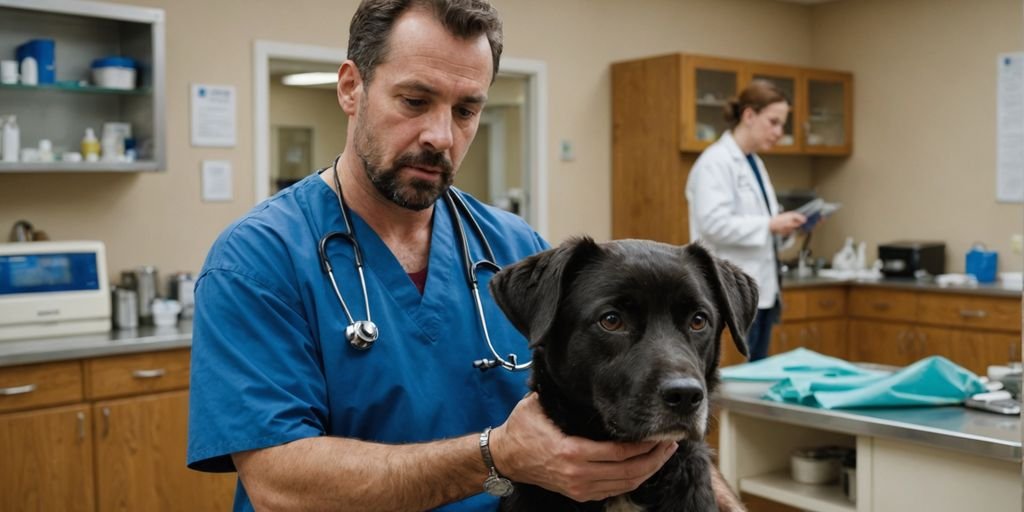Being a pet owner means watching over your furry friend’s health. Sometimes, it’s hard to tell if their odd behavior is normal or a sign of something serious. Knowing the signs that need quick veterinary attention can make all the difference for your pet’s well-being. Here are some common signs that your pet needs to see a vet right away.
Key Takeaways
- General weakness or trouble moving can signal serious health issues in pets.
- Difficulty urinating or changes in bathroom habits should be checked by a vet.
- Heavy breathing and coughing that doesn’t go away might need immediate attention.
- Severe pain or trauma requires an urgent vet visit, even if injuries aren’t visible.
- Refusing to eat or drink for an extended period is a red flag for underlying health problems.
General Weakness and Mobility Issues
Signs of General Weakness
Lethargy is a common sign that something might be wrong with your pet. If your usually active pet suddenly doesn’t want to get out of bed, it could be a sign of illness. Make an appointment with your vet to find out why your pet is feeling weak.
Causes of Mobility Issues
Mobility problems can be caused by many things, including injuries, arthritis, or even obesity. Pets that are overweight are more likely to have trouble moving around. It’s important to keep an eye on your pet’s weight and make sure they get regular exercise.
When to Seek Veterinary Care
If your pet has been limping or refusing to move for several hours, it’s time to see the vet. Chronic mobility issues should not be ignored, as they can lead to more serious problems. Always consult your veterinarian if you notice any changes in your pet’s ability to move.
Struggling to Urinate
Normal Urination Frequency
Dogs typically urinate 3-5 times a day, while cats usually go 2-4 times daily. However, these numbers can vary based on factors like age, diet, and health. It’s crucial to monitor any significant changes in your pet’s urination habits.
Signs of Urinary Problems
If your pet is positioning themselves to urinate but nothing comes out, this is a red flag. Other signs include:
- Frequent attempts to urinate
- Whining or showing signs of pain while urinating
- Blood in the urine
Potential Causes and Treatments
Urinary issues can stem from various causes, such as infections, bladder stones, or even more severe conditions like urinary obstructions. A urinary obstruction is considered a medical emergency and requires immediate action from the dog owner. Treatments may include antibiotics for infections or surgery for obstructions.
If you notice your pet struggling to urinate, don’t wait. Seek veterinary care immediately to prevent further complications.
Heavy Breathing and Coughing

Recognizing Abnormal Breathing
Heavy breathing and coughing in pets can be alarming. If your dog has an increased respiratory rate (usually greater than 30 breaths per 60 seconds) when sleeping or resting, this is a medical emergency. Look for signs like wheezing, nasal discharge, and persistent coughing. These symptoms can indicate serious health issues that need immediate attention.
Common Respiratory Issues
Several conditions can cause heavy breathing and coughing in pets:
- Heatstroke: Rapid breathing, excessive drooling, and poor coordination are classic signs.
- Heart Disease: Symptoms include coughing, especially at night or after exercise.
- Respiratory Infections: Conditions like kennel cough or canine flu can cause persistent coughing and breathing difficulties.
- Allergic Reactions: Swelling of the face, mouth, or throat can lead to breathing problems.
Immediate Actions to Take
If you notice your pet struggling to breathe, take the following steps:
- Move your pet to a cool, shaded area and offer water.
- Check for any visible obstructions in their mouth or throat.
- Monitor their breathing rate and look for any other symptoms like blue gums or tongue.
- Contact your vet immediately or head to an emergency clinic if symptoms persist.
Heavy breathing and coughing are not just minor issues; they can be signs of serious health problems that require prompt veterinary care.
Serious Trauma and Severe Pain
Identifying Severe Pain
Recognizing when your pet is in severe pain is crucial. Signs of severe pain include whining, limping, or an inability to get comfortable. If your pet is crying out when touched or seems restless, it’s time to take action.
Common Causes of Trauma
Trauma can result from various incidents, such as:
- Being hit by a vehicle
- Dog fights and bite wounds
- Falling from a height
- Gunshot wounds
Pets who have experienced trauma should be checked for both external and internal injuries.
Emergency Steps to Follow
In case of severe trauma or pain, follow these steps:
- Stay Calm: Your pet needs you to be calm and collected.
- Assess the Situation: Check for visible injuries and note any signs of distress.
- First Aid: Apply pressure to bleeding wounds and keep a pet first aid kit handy.
- Seek Veterinary Care: Transport your pet to the vet immediately.
Having a first aid kit and knowing emergency contact numbers can save your pet’s life until veterinary care is accessible.
Refusing Food and Water

Signs of Appetite Loss
It’s normal for pets to occasionally skip a meal, but persistent refusal to eat or drink is a red flag. Look for signs like lethargy, weight loss, and a dull coat. If your pet has no appetite but is drinking excessive amounts of water, this may be a reason to seek emergency attention.
Possible Underlying Conditions
Several health issues can cause a pet to refuse food and water, including:
- Dental problems
- Gastrointestinal issues
- Infections
- Kidney disease
- Liver problems
Importance of Immediate Veterinary Attention
If your pet has been refusing both food and water for more than 24 hours, it’s crucial to consult a veterinarian. Early intervention can prevent more serious health complications. Always better to have peace of mind regarding your pet’s health.
A pet refusing food and water could be a symptom of a serious condition. Immediate veterinary care can help identify and treat the underlying issue, ensuring your pet’s well-being.
Vomiting and Diarrhea
When Vomiting is a Concern
Vomiting can sometimes be a common occurrence for pets, but there are times when it should raise alarm. Three or more episodes of vomiting in a single day should prompt a visit to the vet. Inspect your pet’s vomit for strange substances or blood. Logging how much and how often your pet vomits can be helpful information for your vet.
Recognizing Severe Diarrhea
Diarrhea can be just as concerning as vomiting. If your pet has loose stools for more than 24 hours, it’s time to seek veterinary care. Look out for other symptoms like weakness, lethargy, or loss of appetite. These could indicate a more serious issue such as a viral or bacterial infection.
Steps to Take Before Visiting the Vet
- Monitor your pet closely and note any additional symptoms.
- Offer small portions of bland food like boiled chicken or rice to see if symptoms improve.
- Ensure your pet stays hydrated by providing fresh water.
- If symptoms persist or worsen, contact your vet immediately.
Always be aware of your pet’s health and seek medical attention if you notice unusual symptoms. Early intervention can make a significant difference in your pet’s recovery.
Seizures and Neurological Issues

Types of Seizures
Seizures in pets can be classified into several types, including focal seizures, generalized seizures, and cluster seizures. Focal seizures affect only a part of the brain and may cause localized symptoms like twitching or unusual movements in one limb. Generalized seizures, on the other hand, involve the entire brain and can result in loss of consciousness and convulsions. Cluster seizures are multiple seizures occurring within a short period.
Early Warning Signs
Recognizing the early warning signs of a seizure can help you act quickly. Common signs include:
- Sudden changes in behavior
- Unusual vocalizations
- Excessive drooling
- Stiffness or muscle twitching
- Loss of balance
If you notice any of these signs, it’s crucial to monitor your pet closely and prepare for the possibility of a seizure.
Emergency Management of Seizures
When a seizure occurs, it’s essential to stay calm and follow these steps:
- Ensure Safety: Move any objects that could harm your pet during the seizure.
- Time the Seizure: Note the duration of the seizure to provide accurate information to your vet.
- Avoid Restraint: Do not try to hold your pet down; this can cause injury.
- Seek Veterinary Care: Contact your vet immediately, especially if the seizure lasts more than a few minutes or if multiple seizures occur in a short time.
Quick action and proper management can make a significant difference in your pet’s health during a seizure. Always consult your vet for guidance and treatment options.
Understanding the types, early signs, and emergency steps for seizures can help you provide the best care for your pet in critical moments.
Seizures and other neurological problems in pets can be scary and confusing. It’s important to know the signs and get help quickly. If your pet shows any unusual behavior, don’t wait. Visit our website for more information and tips on how to keep your furry friend safe and healthy.
Conclusion
As a pet owner, it is your duty to keep an eye on your pet’s health and well-being. Pets can’t tell us when they’re feeling sick or hurt, so it’s up to us to notice the signs. If you see any unusual behavior or symptoms, don’t wait. Take your pet to the vet right away. Quick action can make a big difference in your pet’s health and happiness. Always remember, when in doubt, it’s better to be safe and get a professional opinion.
Frequently Asked Questions
What should I do if my pet is weak and can't move?
If your pet is showing signs of weakness and has trouble moving, it’s best to take them to the vet right away. These could be symptoms of a serious health issue.
How often should my pet urinate?
Dogs usually urinate 3-5 times a day, while cats go about 2-4 times a day. If your pet is having trouble urinating, see a vet as soon as possible.
When is heavy breathing and coughing in pets a concern?
If your pet is breathing heavily or coughing for more than a few days, take them to the vet. It could be a sign of a lung infection or other serious condition.
What are the signs that my pet is in severe pain?
Signs of severe pain in pets include not moving, whimpering, or taking on weird postures. If you notice these, get them to a vet immediately.
Why is my pet refusing to eat or drink?
If your pet won’t eat or drink and seems weak or unwell, it could be due to an underlying condition. Take them to a vet to find out what’s wrong.
How can I tell if vomiting and diarrhea in my pet are serious?
If your pet vomits or has diarrhea more than three times in a day, it’s time to see the vet. Check for unusual substances or blood in the vomit or stool.


